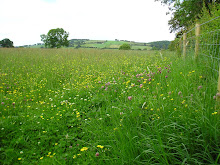
Possibly the most exciting moment of the year, first opening.
At last the sun has put in an appearance for 2 days in a row. Although low in the sky it shines directly at the front of our hives and was sufficient today to encourage one or two of the bolder workers out for a flight.
With immaculate timing yesterday our beekeepers association L&DBKA held an "Oxalic Acid meeting" at Andy's apiary. It was very useful to see his hives opened briefly for treatment. His colonies were in good heart with plenty of bees and stores. He worked smoothly and quickly so that none of the hives was open for more than about 30seconds.
Oxalic acid is found naturally in Rhubarb leaves. Used in very dilute form (3.2%) it is a contact killer of the Varroa mite. During this cold season there is virtually no brood for the mites to live on so they are located on the bees and they are not themselves multiplying at any significant rate. A syringe is used to dribble a small quantity on to the bees. They don't like it much but it does them no harm. The decision whether or not to treat is personal to the beekeeper. My view is that the risk in opening the hive and treating is far less than the risk of damage to the colony if the mites are allowed to multiply unchecked.
So today, having mixed up a dose and treated his own bees, Hamish called round at 2.00pm at the warmest time of the day and we treated our colonies.
Hive 1, the original colony, proved to have 5 seams of bees and plenty of capped honey stores. For the purpose of treatment the frames are not moved. A "seam" is simply the gap between two frames. We are told that very roughly a full seam contains about 4000 bees.
Hive 2, the smaller nucleus colony acquired last July, had 4 good seams of bees again with plenty of stores.
Hive 3, last seasons prime swarm, had 5 good seams of bees plus stores.
Bearing in mind the recent intense cold it is a great relief to find that the colonies are in good order. Now the crucial task is to ensure that the bees continue to have plenty of stores. They will use them at a great rate as soon as the queens start to lay again and will almost certainly require feeding.
So far so good! PS The pic shows backlit comb after cleaning by the bees.



